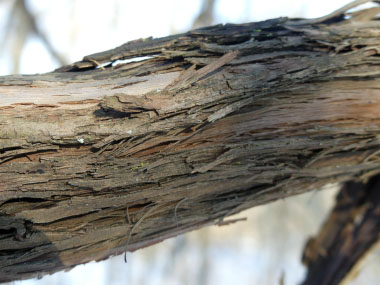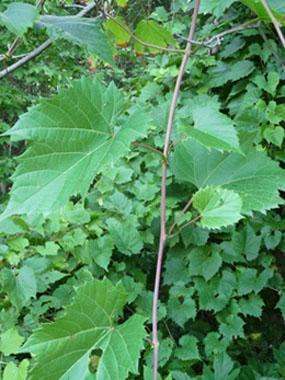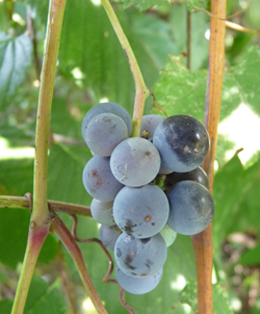






To support our efforts please browse our store (books with health benefits, etc.).
IMPORTANT: A similar plant named Menispermum canadense (common moonseed) is poisonous. Click here for more. (Grape vine leaves taste like grapes.)
The wild grape vine is truly a vining plant; this means it has no solid, upright trunk. This climbing, multi-stemmed vine can grow so well it can totally envelop bushes and trees. Although the wild grape vine is also known as the riverbank grape, it grows well in locations other than riverbanks. There are dozens of species of wild grapes found growing throughout the world. All are perennial, woody vines that are deciduous. Grape vines grow thicker and higher than most other native vines.
Distinguishing Features
The wild grape vine climbs very well due to forking tendrils. (These are narrow branches that grasp by coiling themselves around anything they can.) Grape tendrils most often are found growing from a stalk opposite from a leaf. Most grape vines produce deeply lobed leaves similar to the cultivated grape. Wild grapes grow in pyramidal, hanging bunches and are blackish, dark blue or purple.
Flowers
Tiny white flowers in elongated clusters grow up to 10 cm in length. They bloom in early summer, after which tiny clusters of hard, green grapes develop. In late summer these grapes ripen. Wild grape vine flowers are hermaphrodite and are insect pollinated.
 Fields
of Nutrition has medicinal benefits and vitamin/mineral content of Wild Grape Vine.
Fields
of Nutrition has medicinal benefits and vitamin/mineral content of Wild Grape Vine.
Leaves
The leaves can grow up to 15cm (6") long and 10cm (4") across; they alternate along the stems. The leaves are cordate or orbicular in overall shape, and palmately lobed (often only three lobes are clearly visible). The leaves can grow up to 15cm (6") long and 12cm (4") across; they alternate along the stems. Leaves are shallowly to deeply lobed with (usually) 3 major lobes and a broad gap between the 2 basal lobes. Edges are hairy and sharply toothed. Young leaves are often shiny. As it matures they become green. Leaf stalks are up to 10cm (3") long, often reddish, and variously hairy or smooth.
Height
Grape vines can reach heights of 17 metres.
Habitat
Wild grape vines grow in many locations such as along roadsides, fence rows, forest edges and along river banks. They are also sometimes found in hardwood forests, growing up along with the trees after logging, fire, or a windfall as they cannot reproduce in the shade.
Edible Parts
The ripe grape can be eaten but tastes better after the first frost. They are not that large so eating them as a trail snack is suggested. Making juice from these is a great way to benefit from their goodness and the grapes freeze well so they can be used for juice throughout the winter. The leaves are also edible. They can be eaten in a salad (they have a tangy citrusy taste) or cooked. Throughout the Mediterranean, grape leaves are stuffed with rice, meat and spices. These are known as Dolma and there is also Warak Enab. The leaves can be blanched and frozen for use throughout the winter months.
Other Name
Riverbank Grape.
Similar Plants
Recipes
Grape Leaf Burritos, Preserved Grapevine Leaves, Stuffed Grape Leaves, Taco Grapevine Leaves, Wild Grape Chiffon Cake, Wild Grape Juice, Wild Shrub, Turkish Delight
Winter Survival Food Handbook

PDF Plant Magazines
Types of Wild Food
Geographic Zones Seasons
Disclaimer
EdibleWildFood.com is informational in nature. While we strive to be 100% accurate, it is solely up to the reader to ensure proper plant identification. Some wild plants are poisonous or can have serious adverse health effects.
We are not health professionals, medical doctors, nor are we nutritionists. It is up to the reader to verify nutritional information and health benefits with qualified professionals for all edible plants listed in this web site. Please click here for more information.
Why Edible Wild Food?
- Food costs are rising
- Free, wild food is readily abundant
- Wild food adds nutrition to your diet
- Wild food can help treat various medical conditions





